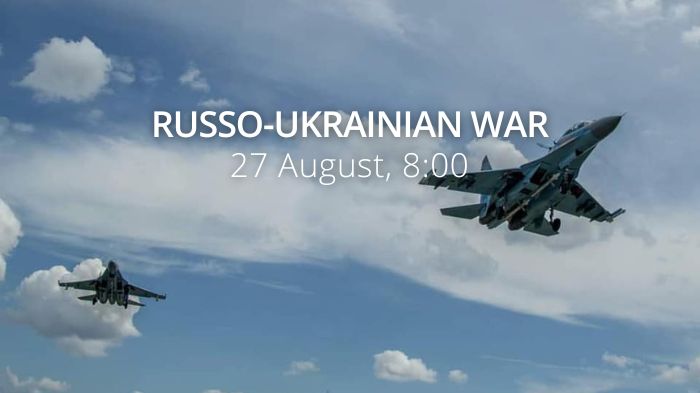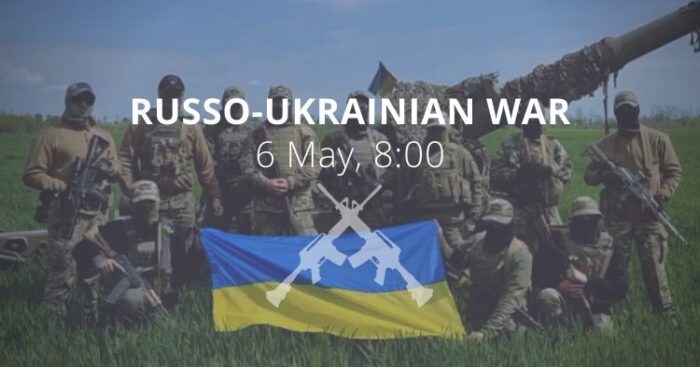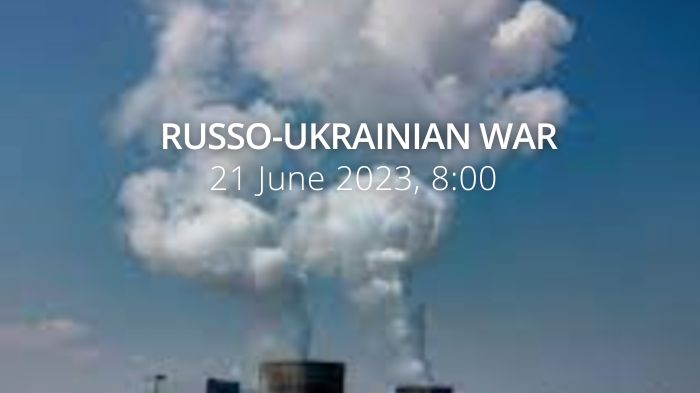Russian forces conducted limited ground attacks southwest of Izium, northeast, and south of Bakhmut, and on the northwestern outskirts of Donetsk City. Ukrainian forces continued targeting Russian ground lines of communication, supply lines, and military infrastructure in Kherson Oblast. Ukrainian army struck an enemy military base in Kadiivka and 200 Russian paratroopers were eliminated. Ukraine appeals to UNESCO as Russians threaten child abductions in occupied areas. Ukraine purchases enough drugs for protection in case of a nuclear accident. One more power unit resumes operation at Zaporizhzhia NPP. Ukrainian farmers harvest 25.3M tonnes of grain.
A map of the approximate situation on the ground in Ukraine as of 00:00 UTC 27/08/22.
There have been no notable changes to control since the last update. pic.twitter.com/UlzGcl7ooT
— War Mapper (@War_Mapper) August 27, 2022
The General Staff’s operational update regarding the Russian invasion as of 06.00 am, August 27, 2022 is in the dropdown menu below.
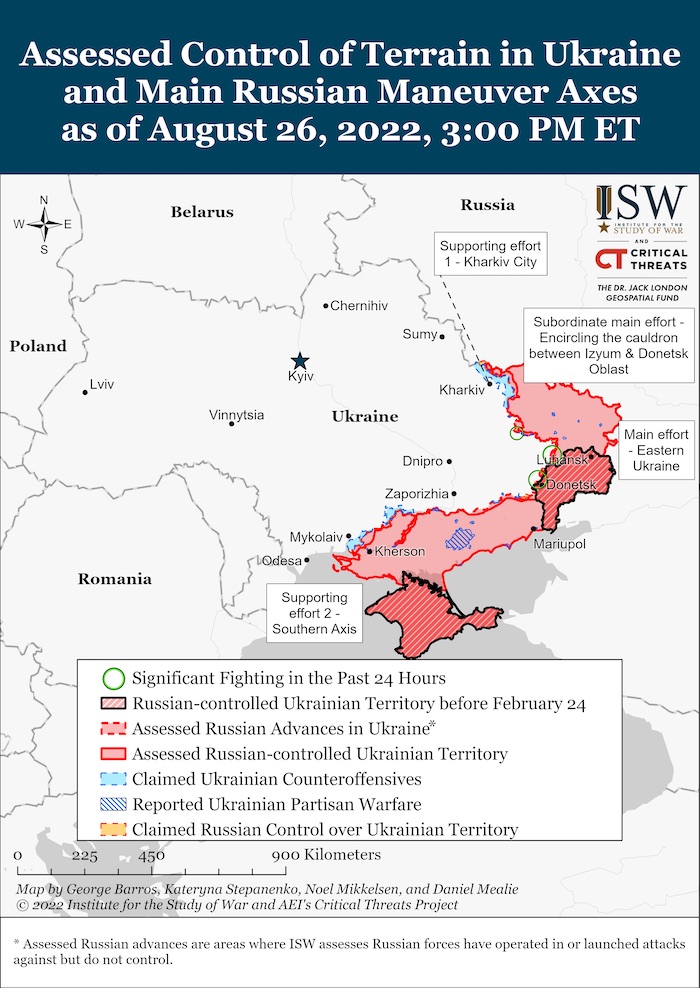
“[Russian forces continue to focus its efforts on establishing full control over the territory of Donetsk oblast, maintaining the captured districts of Kherson, part of Kharkiv, Zaporizhzhia, and Mykolaiv oblasts, restoring the combat capability of units that have suffered losses.]
In the Volyn and Polissya directions, the build-up of radio-electronic intelligence forces and means continues.
In the Siversky region, Russian forces continue to hold separate units of the Western Military District in the border areas of the Bryansk and Kursk regions in order to demonstrate the presence and constrain the actions of units of the Defense Forces of Ukraine. The area of the village of Tovstodubove, Sumy oblast, was fired from barrel artillery. [Yesterday, Russian forces used barrel artillery to shell civilian and military infrastructure in the areas of Seredyna Buda, Shevchenkove, Katerynivka, and Vilne settlements of the Sumy oblast.]
[In the Slobozhansky direction:]

- In the Kharkiv direction, Russian forces fired artillery and MLRS at civil infrastructure facilities in the areas of Svitlichne, Peremoha, Protopopivka, Dementiivka, Petrivka, Cherkaski Tyshky, Odnorobivka, Zamulivka, and Tsyrkuny settlements. Used aviation for a strike near Husarivka. [The occupiers continue to conduct hostilities to maintain the occupied borders. Yesterday, shelling was carried out by tanks, artillery and MLRS near Varvarivka, Udyv, Slatyne, Petrivka, Borschova, Velyki Prokhody, Pischane, Ruski Tyshky, Shestakove, Slobozhanske, Andriivka, and Husarivka. Russian forces also carried out airstrikes near Mospanove, Pervomaiske and Bayrak. Conducted aerial reconnaissance in the areas of Pytomnyk, Cherkaska Lozova and Shestakove settlements.]
- It tried to advance in the direction of Dementiivka with assault actions, but it was unsuccessful and retreated.
- In the Sloviansk direction, Russian forces used barrel artillery and MLRS to shell Dolyna, Dibrivne, and Krasnopilla districts. Conducted aerial reconnaissance near Nova Dmytrivka. In order to disrupt the system of navigation support, the Defense Forces deployed a complex of radio-electronic warfare. [Russian forces are trying to resume the offensive in the direction of the village of Barvinkove. Shelling was recorded near Chepil, Brazhkivka, Bohorodychne and Kostyantynivka. Airstrikes near Brazhkivka and Zalyman.]
- [Yesterday, they conducted an offensive battle in the direction of Karnaukhivka, had no success, and withdrew. Conducted aerial reconnaissance in the area of Nova Dmytrivka.]
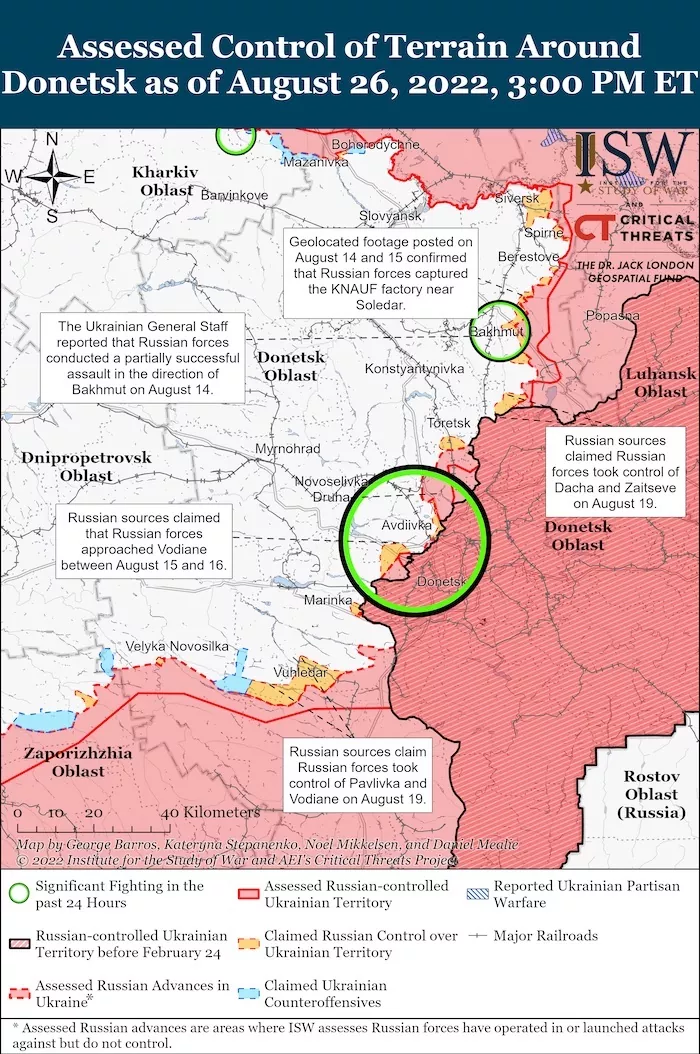
[In the Donetsk direction:]
- In the Kramatorsk direction, areas near Sydorove, Verkhnyokamyanske, Rozdolivka, and Kalenyky were subjected to enemy artillery fire. To clarify the position of our troops, Russian forces conducted aerial reconnaissance by UAV. [Yesterday, Russian forces fired from artillery and MLRS in the areas of Tetyanivka, Ivano-Daryivka, Zvanivka and Hryhorivka settlements. Carried out airstrikes near Spirne and Siversk. Conducted aerial reconnaissance near Tetyanivka.]
- The defence forces repelled an attempted enemy offensive in the direction of Hryhorivka.
- In the Bakhmut direction, Russian forces fired at our troops from available weapons in the areas of the settlements of Bakhmutske, Vesela Dolyna, Zaitseve and Kodema. The areas of Zaitseve and Soledar were hit by enemy aircraft. [Yesterday, Russian forces inflicted fire damage from tanks, barrel artillery, and MLRS in the areas of Tykhonivka, Vasyukivka, Soledar, Bakhmut, and Shumy settlements. Used aviation for strikes near Yakovlivka and Kodema.]
- Separate units of Russian forces attempted to improve the tactical position in the direction of the settlements of Soledar, Zaitseve and Mayorsk. They did not have success and retreated. [Yesterday, the occupiers tried to conduct assaults in the direction of the settlements of Soledar, Bakhmutske, Bakhmut and Kodema, but were unsuccessful.]
- In the Avdiivka direction, Russian forces tried to destroy important objects of civil and military infrastructure with the fire of tanks, artillery and MLRS, to inflict losses on our units near Vodyane, Pervomaiske, Krasnohorivka, Zalizne and Novobakhmutivka. Mariinka and Valentynivka districts were hit by air strikes. [Yesterday, Russian forces shelled the districts of Alexandropil, New York, Novobakhmutivka, Netaylovy, Halytsynivka, Nevelske, Opytne, and Mariinka. Airstrikes near Pervomaiskyi, Krasnohorivka, and Mariinka.]
- With offensive actions, the occupiers tried to advance in the direction of Nevelske but were repulsed and retreated. To adjust the artillery fire, Russian forces conducted aerial reconnaissance by UAV. [Yesterday, the invaders also tried to improve their tactical position in the direction of the settlement of Nevelske, but were repulsed and retreated.]
- In the Novopavlivske direction, enemy units continued shelling the areas of Vuhledar, Novomykhailivka and Velyka Novosilka settlements with the available means of fire damage. Russian forces used aviation for strikes near Volodymyrivka. He led an offensive battle in the direction of the settlement of Prechistivka, had no success, and withdrew. [Yesterday, artillery shelling was recorded near Zolota Nyva, Prechystivka, Pavlivka, and Volodymyrivka. The districts of Volodymyrivka and Novomykhailivka were hit by enemy aircraft.]
- In the Zaporizhzhia direction, fire damage was recorded in the territories near Novopole, Hulyaipilske, Charivne and Shevchenko. The districts of Novopole, Hulyaipilske, Novodanylivka and Olhivske were hit by airstrikes. [Yesterday, Russian forces shelled the areas of the settlements of Velikomykhailivka, Novosilka, Vremivka, Malynivka, Dorozhnianka, Poltavka, Orihiv, and Mala Tokmachka. Carried out airstrikes near Olhivske and Hulyaipole.]
In the Pivdenny Buh direction, the main efforts of Russian forces are concentrated on preventing the advance of our troops. The areas of Nikopol, Oleksandrivka, Stepova Dolyna, Kobzartsi, Ternivka, Topolyne, Andriivka, and Lozove were shelled by tanks, barrel artillery, and multiple rocket systems. It carried out airstrikes near Velike Artakovo, Pervomaiske and Olhany. [Yesteday, Russian forces continued shelling the areas of Mykolaiv, Kryvyi Rih, Lupareve, Prybuzke, Posad-Pokrovske, Novogrigorivka, Partyzanske, Chervona Dolyna, Velyke Artakove, Kvitneve, Ivanivka, Potemkine, Trudolyubivka, Blahodatne, Tavriyske, Pervomaiske, Shyroke and Polyana. Air strikes tried to destroy important infrastructure facilities in the areas of Oleksandrivka, Lozove, and Olhyne settlements.]
- With the forces of the reconnaissance group, the occupiers tried to conduct reconnaissance in the Potyomkino area, but Russian forces were detected and neutralized.
In the Black Sea and the Sea of Azov, a Russian naval group continues to carry out reconnaissance and blockade of civilian shipping in the northwestern part of the Black Sea.”
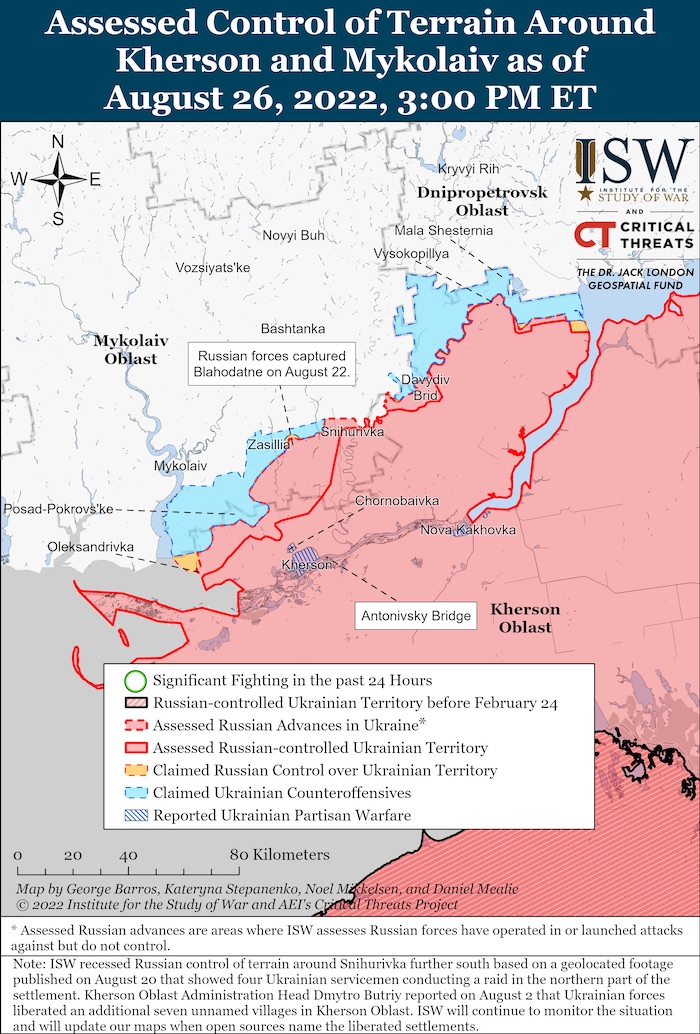
Military Updates
How Russia ran a fake darknet “Javelin shop” for its “Ukrainian weapons black market” myth
Explosions were heard at Russian military depots near Melitopol, Ukrinform reports. “Explosions have been heard [Friday evening] in the Novobohdanivka community, Melitopol District, where Russian occupiers set up their military base.”
Ukraine continues attacking Russian supply lines in the Kherson oblast. Yesterday, the Darivka Bridge in the Kherson region was rendered unusable thanks to the work of Ukrainian rocket and artillery units. The Ukrainian Armed Forces also launched strikes on the Antonivka Bridge.
https://twitter.com/EuromaidanPress/status/1563227964078440448
Russian hackers attacked Ukraine more than 1,000 times since the start of the invasion, Ukrinform reports, citing the press service of the State Special Communications Service of Ukraine. “During the six months of the war, the national Computer Emergency Response Team of Ukraine CERT-UA, which operates under the State Special Communications Service, recorded 1,123 cyberattacks, the report says.
It is noted that cybercriminals most often attacked the central government and local government bodies. Among the main targets are also commercial and financial institutions, agencies of the security and defence sector, enterprises of the energy sector, transport industry and telecom – all essential public infrastructure. As Ukrinform reported, since the beginning of the full-scale invasion, Ukrainian cyber police have repelled 83 enemy cyberattacks and prevented another 300.”
AFU struck an enemy military base in Kadiivka and 200 Russian paratroopers were eliminated, Ukrinform reports, citing Serhiy Haidai, the head of the Luhansk Regional Military Administration. “In the temporarily occupied Kadiivka (Stakhanov) of Luhansk region, Ukrainian soldiers destroyed a base of the rashists, which they had set up in Donbas Hotel. 200 military of the Russian airborne troops were liquidated, the regional governor wrote.”
According to British Defence Intelligence, (last 48 hours):
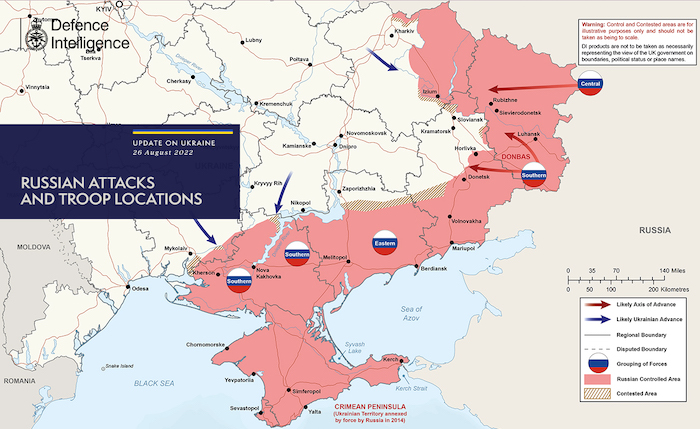
- Over the last five days, there has probably been an increase in the intensity of Russian assaults along the Donetsk sector of the Donbas. North of Donetsk city, there has been intense fighting near the towns of Siversk and Bakhmut. Pro-Russian separatist militia has probably made some progress towards the centre of the village of Pisky, near Donetsk Airport. However, overall, Russian forces have secured few territorial gains.
- There is a realistic possibility that Russia has increased its efforts in the Donbas in an attempt to draw in or fix additional Ukrainian units, amid speculation that Ukraine is planning a major counter-offensive.
- On 24 August 2022, Russian Defence Minister Sergei Shoigu told the Shanghai Cooperation Organisation that Russia was deliberately slowing the pace of its military campaign in Ukraine, driven by the need to reduce civilian casualties.
- This is almost certainly deliberate misinformation. Russia’s offensive has stalled because of poor Russian military performance and fierce Ukrainian resistance. Under Shoigu’s orders, the forces operating in Ukraine have repeatedly missed planned operational timelines. It is highly likely that Shoigu and President Putin have fired at least six generals for not advancing quickly enough.
- On the day Shoigu was speaking, a Russian SS-26 Iskander short-range ballistic missile struck a train in the town of Chaplyne, reportedly killing at least two children. This highlights Russia’s willingness to cause collateral damage when it perceives there is military advantage in launching missile or artillery strikes.
Losses of the Russian army
As of Saturday 27 August, the approximate losses of weapons and military equipment of the Russian Armed Forces from the beginning of the war to the present day:
- Personnel – more than 46500 (+250),
- Tanks – 1939 (+3),
- Armoured combat vehicles – 4254 (+3),
- Artillery systems – 1045 (+5),
- Multiple rocket launchers –MLRS – 274 (+2),
- Air defence means – 148 (+0),
- Aircraft – 234 (+0),
- Helicopters – 202 (+0),
- Automotive technology and fuel tanks – 3165 (+3),
- Vessels/boats – 15 (+0),
- UAV operational and tactical level – 836 (+2),
- Special equipment – 99 (+0),
- Mobile SRBM system – 4 (+0),
- Cruise missiles – – 196 (+0)
Russian enemy suffered the greatest losses (of the last day) in the Donetsk direction.
Putin orders the Russian military to increase troops amid Ukraine’s losses, Military Times reports. “Russian President Vladimir Putin ordered a major buildup of his country’s military forces Thursday in an apparent effort to replenish troops that have suffered heavy losses in six months of bloody warfare and prepare for a long, grinding fight ahead in Ukraine. The move to increase the number of troops by 137,000, or 13%, to 1.15 million by the end of the year came amid chilling developments on the ground in Ukraine.
Putin’s decree did not specify whether the expansion would be accomplished by widening the draft, recruiting more volunteers, or both. But some Russian military analysts predicted heavier reliance on volunteers because of the Kremlin’s concerns about a potential domestic backlash from an expanded draft. The move will boost Russia’s armed forces overall to 2.04 million, including the 1.15 million troops.”
According to ISW, “the announcement of a relatively modest (yet likely still unattainable) increased end strength target strongly suggests that Putin remains determined to avoid full mobilization. The Kremlin is unlikely to generate sufficient forces to reach an end strength of over 1,150,000 soldiers as the decree stipulates. The Russian military has not historically met its end-strength targets. It had only about 850,000 active-duty military personnel in 2022 before Russia’s full-scale invasion of Ukraine, for example, well shy of its nominal end strength target of over one million.”
Humanitarian
Husband and wife found dead in Russian-occupied Arkhanhelske, Kherson Oblast
The Pavlenko couple were found dead in their home's cellar on Aug24 morning. Previously, the Russian military broke into their home at least 3 times, according to locals.https://t.co/qMj4etcXe9 pic.twitter.com/PmYNdOe1ld
— Euromaidan Press (@EuromaidanPress) August 26, 2022
Ukraine appeals to UNESCO as Russians threaten child abductions in occupied areas, Ukrinform reports, citing MFA spokesman Oleg Nikolenko. “The Ministry of Foreign Affairs of Ukraine has called on UNESCO to urgently respond to Russia’s threats to parents in the temporarily occupied Kherson and Zaporizhzhia regions to send their children to orphanages if they refuse to enrol them in schools.”
Government purchases enough drugs for protection in case of a nuclear accident – Healthcare Minister, Ukrainska Pravda reports. According to Viktor Liashko, Minister of Health of Ukraine, “the government has purchased enough drugs that will allow us to protect the thyroid gland so that radioactive iodine does not have a negative effect, and they will be issued when necessary. All healthcare facilities in the potential impact zone are being supplied with this drug. The warehouses of oblasts have a large amount of the drug in stock in order to deliver it in time to where it is needed in the case of an accident, depending on where the radioactive dust might spread.
In early August, the Ministry of Health published an algorithm of actions in the event of a radiation accident. Later, clarifications were provided as to who and when, as well as how much potassium iodide one should consume.”
Three more Ukrainian regions are to face mandatory civilian evacuation, Ukrinform reports, citing Deputy Prime Minister, Minister for Reintegration of the Temporarily Occupied Territories Iryna Vereshchuk. “Kharkiv, Zaporizhzhia, and Mykolaiv regions are in line for mandatory evacuation. I’m not talking about these entire regions, but parts of them will require evacuation, so we’re also preparing for it,” Vice PM said.
Almost 35,000 people, 10,000 of them children, were evacuated from Kherson, Donetsk, Zaporizhzhia, and Luhansk regions since August 1.”
Ukraine exported its first million tonnes of agricultural products over the past month, Ukrinform reports. “Ukraine has exported its first million tonnes of agricultural products via three sea ports over less than a month since the grain export initiative was launched. Ukrainian grain and the fact that our direction of supply to the global food market has restored will allow us to avoid chaos in the market, reduce the severity of the food crisis and prevent catastrophic shortages. Ukraine was, is and will be among the global food security guarantors, the President of Ukraine stressed.”
Ukrainian farmers harvest 25.3M tonnes of grain, Ukrinform reports, citing the Ukrainian Agrarian Policy and Food Ministry. “As of August 25, 2022, Ukrainian agricultural producers harvested 25.3 million tonnes of grain. This includes 18.8 million tonnes of wheat, 246.1 thousand tonnes of peas, 2.0 thousand tonnes of buckwheat and 1 thousand tonnes of millet. In addition, Ukrainian farmers have already gathered 18.8 thousand tonnes of sunflower seeds and 3.1 million tonnes of rapeseed.
A reminder that Ukraine’s gross yield of grain and oilseed crops is expected to reach 65-67 million tonnes this year, according to the Ukrainian Agrarian Policy and Food Ministry.”
Millions of refugees from Ukraine have crossed borders into neighbouring countries, and many more have been forced to move inside the country. The escalation of conflict in Ukraine has caused civilian casualties and destruction of civilian infrastructure, forcing people to flee their homes seeking safety, protection and assistance the UNHCR reports. As of 23 August:
| Individual refugees from Ukraine recorded across Europe: | 6,858,825 |
| Belarus, Hungary, Republic of Moldova, Poland, Romania, Russian Federation, Slovakia | 3,541,398 |
| Other European countries | 2,835,858 |
| Refugees from Ukraine registered for Temporary Protection or similar national protection schemes in Europe: | 3,933,695 |
| Hungary, Poland, Romania, Slovakia | 1,512,294 |
| Other European countries | 2,421,401 |
| Border crossings from Ukraine (since 24 February 2022): | 11,536,470 |
| Border crossings to Ukraine (since 28 February 2022): | 4,984,904 |
️️Environmental
IAEA mission's visit to the occupied Zaporizhzhya NPP planned for next week
Russia is "now artificially creating all the conditions for the mission not to reach the facility and examine the situation around it" – Lana Zerkal, adviser to Energy Ministerhttps://t.co/yoh2ZVI0lT
— Euromaidan Press (@EuromaidanPress) August 26, 2022
One more power unit resumes operation at Zaporizhzhia NPP, Ukrinform reports, citing Energoatom National Nuclear Energy Generating Company of Ukraine. “At 09:15 p.m., August 26, 2022, one more power unit of Zaporizhzhia Nuclear Power Plant (NPP), which was cut off yesterday, was connected to the power grid and is gaining power. There are no issues related to the operation of equipment and safety systems,” the report states. According to Energoatom, one of two power units, which used to be disconnected from the power grid, resumed operation at 02:04 p.m. Thus, despite numerous provocations launched by Russian occupiers, Zaporizhzhia NPP continues to operate as part of Ukraine’s energy system and meet the country’s electricity needs.
On August 25, 2022, due to fires in the ash dumps of Zaporizhzhia Thermal Power Plant (TPP), which is situated close to Zaporizhzhia NPP, the remaining fourth line connecting Zaporizhzhia NPP and Ukraine’s energy system twice was cut off. The other three lines were damaged by Russian projectiles earlier. As a result, Zaporizhzhia NPP had been fully left without power for the first time in its history.”
#Zaporizhzhia: the head of the military regional administration Oleg Buryak calls out for the international community and agencies, @iaeaorg, @UN, and #RedCross to prevent a disaster.
"50 km area around #ZaporizhzhiaNPP should be demilitarized."
🎥 @ZarinaZabrisky pic.twitter.com/rMSdnTuf7p
— Euromaidan Press (@EuromaidanPress) August 26, 2022
Russia burns gas into the atmosphere while cutting supplies to the EU, Reuters reports. “Russia is wasting large volumes of natural gas by burning it in a huge orange flare near the Finnish border at a time when it has sharply cut deliveries to the European Union, scientists and analysts said on Friday.
Russia has cut flows through Nord Stream 1 to just 20% of capacity and plans to shut it down entirely for three days next week, citing maintenance issues with turbines. The EU accuses it of using gas as a weapon to fight back against Western sanctions over Ukraine.
Flaring is a common practice in oil and gas production, but the current level is unusually high and the timing is sensitive because of the Russian supply cuts. Rystad analysts wrote: Exact flaring volumes levels are hard to quantify but are believed to be at levels of around 4.34 million cubic meters per day. This equates to 1.6 billion cubic meters (bcm) on an annualized basis and is equal to around 0.5% of the EU’s gas demand needs.”
Legal
Russia's war crimes in Ukraine before the full-scale invasion of Feb 2022
"We might have forgotten a little that Russia committed war crimes in Ukraine even before 2022," the authors of the infographics noted.https://t.co/PiSXv9fZYi pic.twitter.com/ldcv5BXpiw
— Euromaidan Press (@EuromaidanPress) August 26, 2022
At a Russian “summer camp” near Mariupol, children are trained to shoot and hate Ukraine, Ukrainska Pravda reports, citing Mariupol City Council. “The occupiers are continuing to play by the Nazi rulebook. The collaborators are attempting to turn the children from Mariupol into Hitler Youth [the youth organisation of the Nazi Party – ed.].
They [the Russian occupiers and their collaborators] have launched a summer camp in Melekino where [the children] are brainwashed and taught how to shoot and to hate Ukraine.”
In Mariupol, occupiers intimidate parents and force them to send children to local schools, Ukrainska Pravda reports, citing Petro Andriushchenko, the advisor to the Mariupol mayor. “Parents in Mariupol are being forced to send their children to schools headed by the occupying administration. If parents refuse, the occupiers are threatening to deprive them of their parental rights and take away their children. He attached a screenshot with threats sent by teachers who are collaborating with the occupiers.
“Notification from the school administration! In case you haven’t decided on the preferred education format, you must bear in mind that there will be no distance learning on our liberated territory!
If your child doesn’t go to school, we will submit this information to the department, they will hand this over to the police. The police will come to you, and the first time, [you] will [get] a warning; the second time, there will be a 40,000 roubles fine; and the third time, you will be deprived of your parental rights, says the message.”
377 children were killed, 733 children injured, 7,013 deported by foe forces, and 226 reported missing – the Office of the Prosecutor General of Ukraine reports as of August 27. 2,328 educational establishments are damaged as a result of shelling and bombings, 289 of them are destroyed fully. 30,412 crimes of aggression and war crimes and 14,208 crimes against national security were registered.
Court declares Russian Sberbank's Czech subsidiary bankrupt – Radio Prague International
The Prague City Court declared bankruptcy on Sberbank CZ, the Czech subsidiary of the Russian Sberbank.https://t.co/Op6QuWyNm3
— Euromaidan Press (@EuromaidanPress) August 26, 2022
Support
.@BorisJohnson condemns Russia's 'cultural vandalism' in Ukraine
Johnson has accused Russian forces of trying to erase Ukrainian culture in occupied areas in his video message to the Edinburgh International Culture Summit.https://t.co/iDWEiZpk9p
— Euromaidan Press (@EuromaidanPress) August 26, 2022
There are currently more than 20 HIMARS, M270 and MARS multiple rocket systems in service with the Ukrainian Armed Forces, The Ministry of Defence of Ukraine reports. They defend a frontline of more than 2,450 km. More than 50 Russian depots with weapons and ammunition have been destroyed so far.
A month ago, the head of the US Armed Forces Committee told how many HIMARS Ukraine can get. “I think the goal now is to reach the number of 25-30 rocket launchers, he said. According to him, it will be a combination of HIMARS and several MLRS systems from the UK and others. We will try to provide as many as we can. But 50 or 60 installations will be difficult to collect and provide, however, we want to reach the figure of 25 or 30 and provide as much artillery and missiles as possible for these systems, The Chairman of the Armed Forces Committee of the US House of Representatives, Adam Smith, said.”
Lithuania to buy 37 kamikaze drones for Ukraine, Ukrinform reports. “Part of the funds collected by #LegionOfBoom (1,000,000 euros) will be transferred to the Lithuanian Ministry of National Defense and will be used for the purchase of 37 kamikaze drones from Poland and then sent to Ukraine. Thank you, everyone, who made donations! Lithuanian Defense Minister Arvydas Anusauskas wrote.
The Legion of Boom campaign raising funds to arm Ukraine, organized by Lithuanian journalist Andryus Tapinas, was timed to Ukraine’s Independence Day. According to Tapinas, by the time the fundraiser was completed, Lithuanians had donated EUR 1.545 million.”
Bundestag politician calls on Germany to supply more heavy weapons to Ukraine, Ukrinform reports, citing NTV. “Anton Hofreiter, chairman of the Europe Committee in the German Bundestag, has called for more heavy weapons to be supplied to Ukraine from Bundeswehr stocks. Hofreiter said he is firmly convinced that further arms deliveries to Ukraine could lead to a faster end to the war. In view of this, the Bundeswehr could be weakened in the short term.
It’s not a catastrophe for the Bundeswehr if they get their weapons replaced next year or the year after, he said, adding that Ukraine needs weapons “immediately”, including armoured personnel carriers and battle tanks. Asked how long the conflict could last, Hofreiter said: I am firmly convinced that the more weapons we deliver, the faster the conflict will end because the higher the costs for Putin and his regime.”
New Developments
German FM @ABaerbock "signals openness in Russian entry ban debate" – DW
FM Baerbock said that @OlafScholz had never rejected the idea of entry restrictions absolutely.https://t.co/M2Nfe1dwWu pic.twitter.com/XQquNmzriO
— Euromaidan Press (@EuromaidanPress) August 26, 2022
- Russia can’t stop the war, even if Ukraine drops NATO hopes, Reuters Former President Dmitry Medvedev, now deputy chairman of Russia’s Security Council, said that Russia was prepared to hold talks with Ukrainian President Volodymyr Zelensky subject to certain conditions. “Renouncing its participation in the North Atlantic alliance is now vital, but it is already insufficient in order to establish peace,” Medvedev told LCI television in quotes reported by Russian news agencies. Russia, he said, would continue the campaign until its goals had been achieved. Putin says he wants to “denazify” Ukraine. Kyiv and the West say this is a baseless pretext for a war of conquest.”
- Lukashenko threatens the West that Belarusian aircraft to carry Russian nuclear weapons, Ukrainska Pravda reports, citing Belta. “Aleksandr Lukashenko, the self-proclaimed president of Belarus, announced the conversion of Belarusian Su-24 aircraft to carry nuclear weapons. Lukashenko added that targets had already been set in case of provocation by the West against Belarus.”
- Borrelll calls the situation around the ZNPP “extremely concerning”, Ukrainska Pravda “Josep Borrelll, the European Union’s high representative for foreign affairs, demands that the Russian Federation ensure the unhindered repair of power lines and the full connection of the Zaporizhzhia NPP to the Ukrainian electricity grid.”
- The left wing of Scholz’s party demands that Germany stop providing weapons to Ukraine and start negotiations with the Russian Federation, European Pravda reports, citing Spiegel. “Representatives of the left wing of the Social Democratic Party of Germany, whose leader is the current Chancellor Olaf Scholz, called for an end to the supply of heavy weapons to Ukraine and peace negotiations with Russia. Continuing the war will only lead to more casualties and destruction. We need a ceasefire as soon as possible as a starting point for comprehensive peace negotiations, the letter reads. The leftists also oppose the supply of heavy weapons to Ukraine and point to the danger of nuclear war: With each supply of weapons, it is important to carefully consider where the “red line” lies, which can be perceived as an entry into war and cause an appropriate reaction.”
- Zelensky’s Office Responded to Scholz’s Fellows Party Members, Who Called For Ceasefire in Ukraine, European Pravda “Once again, point by point. The Russian army brings only death, destruction, and torture. Western weapons bring peace by helping us protect our children. I invite everyone who calls on Germany to stop backing Ukraine to visit Bucha. Let’s discuss your arguments with the families of the murdered Ukrainians, Mykhailo Podoliak, the adviser to the President of Ukraine Volodymyr Zelensky, wrote on Twitter.”
- Zelensky says danger remains after nuclear plant resumes power supply, Reuters “Ukraine’s president on Friday said the situation at the Zaporizhzhia nuclear power plant remains “very risky” after two of its six reactors were reconnected to the grid following shelling that caused Europe’s largest nuclear power plant to be disconnected for the first time in its history.”
- Russia is a strategic challenge for NATO in the arctic, Stoltenberg says, Reuters “Russia’s capabilities in the North are a strategic challenge for NATO, its Secretary General Jens Stoltenberg said on Friday. […] Russia has reopened hundreds of Soviet-era military sites in the Arctic, using the region to test new weapons systems, Stoltenberg said. He also warned that Russia and China were forming a strategic arctic partnership that challenged NATO’s values and interests.”
Assessment
- On the war.
Map https://www.understandingwar.org/backgrounder/russian-offensive-campaign-assessment-august-20*
The Institute for the Study of War has made the following assessment as of Friday 26 August:
“Russian forces did not make any claimed or assessed territorial gains in Ukraine on August 26, 2022, for the first time since August 18, 2022. However, Russian forces still conducted limited and unsuccessful ground attacks on the Eastern Axis on August 26.
The International Atomic Energy Agency (IAEA) stated that unspecified actors (but almost certainly Russian forces) reconnected part of the Zaporizhzhia Nuclear Power Plant (ZNPP) to the Ukrainian power grid on August 26. Ukrainian nuclear operating enterprise Energoatom stated that unspecified actors reconnected one of the power units to the ZNPP and are working to add capacity to the ZNPP’s operations. Russian forces remain in full control of the plant, though it is unclear why they would have reconnected the power unit.
Russian occupation authorities remain unlikely to successfully conduct sham referenda to annex Ukrainian territory into the Russian Federation by early September, despite reports of advancing preparations for referenda. Spokesperson for Ukraine’s Main Intelligence Directorate (GUR) Vadym Skibitsky stated on August 26 that Russian authorities have completed administrative preparations for referenda and created election headquarters, drawn up voter lists, and created election commissions, which Skibitsky stated indicates that the preparatory process for referenda is “almost complete.” Russian-backed occupation authorities in Zaporizhzhia Oblast announced that they have already audited polling stations, analyzed voter lists, and selected candidates for work in voter precincts and territorial election commissions.
However, Russian occupation authorities are unlikely to be able to carry out referenda as they intend (with cooperation from local collaborators) by the purported September 11 deadline due to continued frictions within occupation administrations and ongoing partisan attacks. The Ukrainian advisor to the head of Kherson Oblast, Serhiy Khlan, stated on August 26 that the Kherson occupation administration is struggling to find people to head administrative units in charge of referendum preparations, likely due to a lack of willing locals and low levels of trust in Ukrainian collaborators. Khlan notably stated that Russian President Vladimir Putin may have ordered occupation administrators to avoid importing Russian administrators to fill these roles in order to make the referendum process appear like a grassroots initiative with local support. Ukrainian sources have previously reported that Ukrainian resistance and increasing partisan attacks are inhibiting preparations for the referendum. While Russian authorities could hypothetically forcibly annex Ukrainian territories on an arbitrary date, they are unlikely to do so without holding staged referenda. All observed indicators suggest that Russian authorities seek to create a veneer of local support and participation before conducting the referenda to frame them as widely supported initiatives but face ongoing setbacks that will delay any annexation effort.
Key Takeaways
- The International Atomic Energy Agency (IAEA) stated that elements of the Zaporizhzhia Nuclear Power Plant (ZNPP) reconnected to the Ukrainian power grid on August 26.
- Russian occupation authorities remain unlikely to successfully conduct sham referenda to annex Ukrainian territory into the Russian Federation by early September, despite reports of advancing preparations for referenda.
- Russian forces conducted limited ground attacks southwest of Izium, northeast and south of Bakhmut, and on the northwestern outskirts of Donetsk City.
- Ukrainian forces continued targeting Russian ground lines of communication (GLOCS) and military infrastructure in Kherson Oblast which support operations on the west bank of the Dnipro River.
- Russian federal subjects (regions) continued additional recruitment drives for volunteer battalions, which continue to deploy to Ukraine.
Ukrainian partisans and internal division continue to pose threats to Russian control of occupied territories.“
Ukraine Weighs a Risky Offensive to Break Out of a Stalemate, The New York Times reports. “Both Russia and Ukraine are preparing for a protracted standoff, but Ukraine has a greater incentive to try to avoid it. For months Russian and Ukrainian soldiers have waged a brutal war across a 1,500-mile front line, inflicting casualties, fighting to the point of exhaustion and making slow gains in territory when they were not suffering costly setbacks. […] A battlefield stalemate prevails, with hostilities at a simmer, amid anxious uncertainty over whether — and when — Ukraine will launch a counteroffensive to try to break the deadlock.
The timing for any such attack has emerged as a pivotal decision for Ukraine’s government. Both sides are preparing for a protracted war, but Ukraine has greater incentive to try to avoid it with potentially risky maneuvers as early as this fall — before the rainy season turns the countryside into impassable bogs, or energy shortages and soaring costs undermine European support.
An offensive is risky, said Michael Kofman, the director of Russian studies at C.N.A., a research institute in Arlington, Va., assessing Ukraine’s options. If it fails, the outcome could affect external support,’ he said. On the other hand, Kyiv likely sees this as a window of opportunity, beyond which lies the uncertainty of a protracted war against a Russian army that has had time to entrench.
From the Ukrainian perspective, the mostly static trench fighting cannot go on indefinitely. Leaving Russia in control of much of the southern coastline would cripple Ukraine’s economy, already cratering from the war and propped up by Western aid. It would also give space to Russia to solidify control in areas it has captured, blanketing news media and school curriculum with its propaganda, arresting or driving out opponents, and potentially declaring the land part of Russia after staging sham referendums. […]
But numerous signs suggest that Mr. Putin will […] settle instead on a strategy of plodding offense designed to exhaust and kill Ukrainian forces. The latest evidence came on Thursday, when the Kremlin published Mr. Putin’s order increasing the target size of the armed forces by 137,000, to 1.15 million. Analysts said the decree hinted that Mr. Putin was preparing for a long and grinding war, but not necessarily a large-scale draft that would mark a major escalation and perhaps prompt a domestic backlash.
Expectations that this will end by Christmas or that this will end by next spring are misguided, said Ruslan Pukhov, a defense analyst who runs the Center for Analysis of Strategies and Technologies, a privately-owned think tank in Moscow. I think this will last a very long time. […]
In Russian state media, the message that Russia might be only at the start of a long and existential war against the West — now being fought, by proxy, in Ukraine — is sounding with increasing clarity. It is a sharp shift from six months ago, when Ukrainians were depicted as lacking the will to fight and eagerly awaiting Russian “liberation.” […]
While Mr. Putin may be content with a protracted standoff, President Volodymyr Zelensky of Ukraine is in some ways fighting against the clock. The very difficult state of our economy, the constant risks of air and missile attacks and the general fatigue of the population from the difficulties of war will work against Ukraine over time, Andriy Zagorodnyuk, a former defense minister, wrote in the Ukrainska Pravda newspaper. He said the military should be prepared to advance, rather than defend. It makes no sense to drag out the war for years and compete to see who will run out of resources first, he wrote. […]
But several military analysts say there is a disconnect between Ukrainian civilian leaders, pressing for a major victory, and military leaders who want to ensure they have sufficient troops and combat power before conducting a major offensive.
There’s a desire to show international partners that their support will enable Ukraine to win, not just hold on, said Jack Watling, a senior research fellow at the Royal United Services Institute in London, who just returned from Ukraine. And there is an expectation from the Ukrainian people they’ll be able to liberate their territory. But he cautioned, a military offensive needs to be based on conditions on the battlefield, not in the political arena.
Over the last month, the Ukrainians have pivoted to the new strategy of so-called “deep war” — hitting targets far behind the front — after months of grim artillery duels and street fighting in the eastern region of Luhansk, which ultimately fell under Russian control by early July. Using long-range, precision-guided rockets provided by the United States and others, the Ukrainian military has been striking Russian weapons depots, bases, command centers and troop positions deep into occupied territory, including Crimea, the peninsula Mr. Putin seized in 2014.
Ukraine has for months been telegraphing plans for the major battle in the south; the types of weapons it has requested from Western allies and the tactics it pursues on the battlefield offering clues to its strategy.
Tellingly, a recent US military assistance package included armored vehicles with mine-clearing attachments that would be used in a ground advance, suggesting preparations for the opening of what would be a new, ground attack phase of the war. Ukraine pushed back Russian forces that were in disarray in the battle for Kyiv last winter, but has yet to demonstrate it can overrun well-fortified Russian defenses. […]
With the decision on an attack in the south looming, Mr. Zelensky has taken pains to show unity with his generals. At a news conference this week, he praised the commander, General Valeriy Zaluzhny, and denied rumors he intended to dismiss the general.”
- Consequences and what to do?
President Zelensky says the coming winter would be the most difficult in our history, The New York Times reports. President Zelensky warned his nation on Friday that the coming winter would be “the most difficult in our history”. Mr. Putin’s decree on Thursday raised the target number of active-duty Russian service members by 137,000, to 1.15 million.
In the Russian state media, the message that Russia could only be at the start of a long and existential war against the West — now being fought, by proxy, in Ukraine — is sounding with increasing clarity. It is a shift from the messaging six months ago, when Ukrainians were depicted as lacking the will to fight and eagerly awaiting Russian “liberation.”
“We will have fewer Russian tourists in Europe, but the size of the Russian army will increase by 140,000 regular servicemen,” Igor Korotchenko, the editor of a Russian military journal, said on a state television talk show on Thursday. “I expect that this is just the beginning.”
Hans Petter Midttun: “Insanity is doing the same thing over and over and expecting different results.”
During the first 8 years of the war, the strategic messaging from the West was that we should not supply weapons to Ukraine to avoid an escalation of the conflict. We pursued that policy right up to the point when the conflict escalated into a full-scale war.
Despite the very evident failure of the strategy, we continue to uphold the strategy with only minor adjustments. In the face of an unprovoked and unjust Russian assault, we have started supplying Ukraine with weapons and ammunition.
The NATO members are, however, only supplying enough to stop the Russian advance on the ground but not enough to allow it to start an effective counter-offensive. The West is not providing the tools it needs to evict the aggressor from Ukraine, stop Russian air and missile strikes against Ukrainian cities or break the maritime blockade. Ukraine is being denied long-range weapons capable of attacking Russian forces located well behind the frontline.
More importantly, NATO is upholding its policy from 2014 to not deploy military units to Ukraine in support of its defence of Euro-Atlantic security (and Ukrainian independence and sovereignty).
Why? The argument is that a war – which already is a broader conflict between Russia and NATO – might escalate into a broader conflict between Russia and NATO.
NATO is once again basing its strategy on the notion that Russia – despite its multiple threats and statements of being at war with the West – will demonstrate restraint.
Despite the assessment by many analysts, myself included, that the Russian assault on Ukraine is a part of its broader confrontation with the USA, NATO and the EU, our political leaders still hope Russia will stop and seek peace. Despite demonstrating consistent weakness and accepting the tremendous costs of the ”tsunami of ripple effects” from the war, and despite our unwillingness to defend our shared values and principles, having been deterred by the Russian Federation from acting according to NATO’s strategic concept (1999-2022), daily confirming that the Russian nuclear “fait accompli” strategy (blackmail) is effective, and desperately trying to avoid a confrontation at the cost of peace, the Alliance is still basing its strategy on the hope that Russia can be persuaded to accept a peaceful resolution of the war.
We have tried negotiating with Russia from a position of weakness before. As a consequence, we have a war on the European continent.
“Insanity is doing the same thing over and over and expecting different results.” It is time to coerce or defeat Russia from a position of strength.
“You were given the choice between war and dishonour. You chose dishonour, and you will have war.” (Winston Churchill to Neville Chamberlain)




